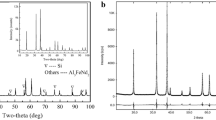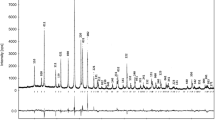Abstract
The magnetic structure of almandine has been investigated by electronic structure calculations in the local spin density approximation in order to arrive at a more detailed understanding of the magnetic structure and the exchange pathways. The calculations are based on experimentally determined geometrical data of the crystal structure at 100 K. The calculated quadrupole splittings, spin-allowed d–d transitions and magnetic moment for iron atoms are in reasonable agreement with the respective experimental values obtained by Mössbauer and absorption spectroscopy, and magnetization measurements demonstrating the reliability of the calculations. The spin structure is derived from the calculated coupling constants for the possible exchange pathways. The competing superexchange pathways exist via oxygen bridges between directly neighboured iron ions and via edges of silicon tetrahedra and aluminium octahedra connecting more distant iron dodecahedra. Careful consideration revealed that almandine structure contains two identical interpenetrative sublattices of Fe dodecahedra connected via Al octahedra and Si tetrahedra. The calculations provide the information about ferromagnetic interaction between the iron spins within each sublattice, whereas the coupling between two magnetic sublattices is weakly antiferromagnetic via Al octahedra and Si tetrahedra. This antiferromagnetic interaction of two identical magnetic sublattices is in good agreement with the experiments and explains the Mössbauer spectra of almandine below the Néel temperature. Since almandine belongs to most abundant crystallized silicates that are main constituents of the earth and main components of cosmic dust, these results have scientific importance of studying the universe.









Similar content being viewed by others
References
Anovitz L, Essene E, Metz G, Bohlen S, Westrum E Jr, Hemingway B (1993) Heat capacity and phase equilibria of almandine, Fe3Al2Si3O12. Geochim Cosmochim Acta 57:4191–4204
Clark S (1957) Absorption spectra of some silicates in the visible and near infrared. Am Miner 42:732–742
de Oliveira JCP, Kunrath J, Vasquez A (1987) The Mössbauer effect in natural almandine: Fe3Al2(SiO4)3. Phys Scripta 36:526–528
de Oliveira JCP, da Costa M, Schreiner W, Vasquez A (1989) Magnetic properties of the natural pyrope-almandine garnets. J Magn Magn Mater 79:1–7
Deer W, Howie R, Zussman J (1997) Rock-forming minerals, vol 1A. The Geological Society, London
Dufek P, Blaha P, Schwarz K (1995) Determination of the nuclear quadrupole moment of 57Fe. Phys Rev Lett 75:3545–3548
ESA (2000a): The crystalline revolution: ISO’s finding opens a new research field, ‘astro-mineralogy’. http://sci.esa.int/science-e/www/object/index.cfm?fobjectid=12856
ESA (2000b): ISO, the hidden Universe and astro-chemistry. http://sci.esa.int/science-e/www/object/index.cfm?fobjectid=26783#P30_5774
Geiger C, Feenstra A (1997) Molar volumes of mixing of almandine-pyrope and almandine–spessartine garnets and the crystal chemistry and thermodynamic-mixing properties of the aluminosilicate garnets. Am Miner 82:571–581
Geiger C, Rossman G (1994) Crystal field stabilization energies of almandine–pyrope and almandine–spessartine garnets determined by FTIR near-infrared measurements. Phys Chem Miner 21:516–525
Geiger C, Armbruster Th, Lager G, Jiang K, Lottermoser W, Amthauer G (1992) A combined temperature dependent 57Fe Mössbauer and single crystal X-ray diffraction study of synthetic almandine: evidence for the Gol’danskii-Karyagin effect. Phys Chem Miner 19:121–126
Geiger C, Grodzicki M, Amthauer G (2003) The crystal chemistry and FeII-site properties of aluminosilicate garnet solid solutions as revealed by Mössbauer spectroscopy and electronic structure calculations. Phys Chem Miner 30:280–292
Goodenough JB (1958) An interpretation of the magnetic properties of the perovskite-type mixed crystals. J Phys Chem Sol 6:287–297
Grodzicki M (1980) A self-consistent charge-Xα method. I. Theory. J Phys B13:2683–2691
Grodzicki M. (1985): Theorie und Anwendungen der Self-Consistent-Charge-Xα Methode. Habilitation thesis, Hamburg
Grodzicki M, Amthauer G (2000) Electronic and magnetic structure of vivianite: cluster molecular orbital calculations. Phys Chem Miner 27:694–702
Grodzicki M, Männing V, Trautwein AX, Friedt JM (1987) Calibration of isomer shifts and quadrupole coupling constants for 119Sn, 127I and 129I as derived from SCC-Xα calculations and Mössbauer measurements. J Phys B20:5595–5625
Grodzicki M, Heuss-Assbichler S, Amthauer G (2001) Mössbauer investigations and molecular orbital calculations on epidote. Phys Chem Miner 28:675–681
Grodzicki M, Redhammer G, Amthauer G, Schünemann V, Trautwein AX, Velickov B, Schmid-Beurmann P (2003) Electronic structure of Fe-bearing lazulites. Am Miner 88:481–488
Grodzicki M, Redhammer G, Reissner M, Steiner W, Amthauer G (2010) Electronic and magnetic structure of pyroxenes I. Hedenbergite. Phys Chem Miner 37:11–23
Huggins FE (1975) The 3d levels of ferrous ions in silicate garnets. Am Miner 60:316–319
Kanamori J (1959) Superexchange interaction and symmetry properties of electron orbitals. J Phys Chem Sol 10:87–98
Keutel H, Käpplinger I, Jäger EG, Grodzicki M, Schünemann V, Trautwein AX (1999) Structural, magnetic and electronic properties of a penta coordinated intermediate-spin (S = 3/2) iron (III) complex with a macrocyclic [N4]2− ligand. Inorg Chem 38:2320–2327
Koepernik K, Eschrig H (1999) Full-potential nonorthogonal local-orbital minimum-basis bandstructure scheme. Phys Rev B59:1743–1757
Lauer S, Marathe VR, Trautwein AX (1979) Sternheimer shielding using various approximations. Phys Rev A19:1852–1861
Manning P (1967) The optical absorption spectra of the garnets almandine-pyrope, pyrope, and spessartite and some structural interpretations of mineralogical significance. Can Miner 9:237–251
Murad E, Wagner F (1987) The Mössbauer spectrum of almandine. Phys Chem Miner 14:264–269
Noodleman L (1981) Valence bond description of antiferromagnetic coupling in transition metal dimers. J Chem Phys 74:5737–5743
Novak GA, Gibbs GV (1971) The crystal chemistry of the silicate garnets. Am Miner 56:791–825
Perdew JP, Wang Y (1992) Accurate and simple analytic representation of the electron-gas correlation energy. Phys Rev B45:13244–13249
Prandl W (1971) Die magnetische Struktur und die Atomparameter des Almandins Al2Fe3(SiO4)3. Z Kristallogr 134:344–349
Ray SN, Das TP (1977) Nuclear quadrupole interaction in the Fe2+ ion including many-body effects. Phys Rev B16:4794–4804
Slater JC (1974) Quantum theory of molecules and solids, vol 4. McGraw-Hill, New York
White B, Moore R (1972) Interpretation of the spin-allowed bands of Fe2+ in silicate garnets. Am Miner 57:1692–1710
Woodland A, Ross C (1994) A crystallographic and Mössbauer spectroscopy study of Fe3 2+Al2Si3O12-Fe3 2+Fe2 3+Si3O12 (almandine-“Skiagite”) and Ca3Fe2 3+Si3O12-Fe3 2+Fe2 3+Si3O12 (andradite-“Skiagite”) garnet solid solution. Phys Chem Miner 21:117–132
Zherebetskyy D, Amthauer G, Grodzicki M (2010) Electronic and magnetic structure of pyroxenes: II orthoferrosilite. Phys Chem Miner 37:455–464
Acknowledgments
Financial support for this study was provided by the FWF (grant number P18805-N17). All calculations have been carried out at the Dept. of Computer Sciences in Salzburg.
Note added in proof
Additional calculations by one us (S.L.) with the full-potential local orbital code FPLO7.00-28 (Koepernik and Eschrig 1999) in the nonrelativistic mode with the PW92 functional (Perdew and Wang 1992) on two almandine clusters with 89 atoms and with 101 atoms, respectively, yield results virtually identical with the SCC-X α values. For the cluster with 89 atoms comprising three edge-shared dodecahedra the magnetic coupling constant J = +5.6 cm−1, and the magnetic moment of Fe is derived as 4.59 μB. For the cluster with 101 atoms describing the magnetic interaction between Fe atoms in two dodecahedra connected by an Al octahedron antiferromagnetic coupling is obtained with J = −1.1 cm−1 and the magnetic moment of Fe is 4.51 μB. Altogether, these results confirm the reliability of the SCC-X α code in computing magnetic structures of complex systems.
Author information
Authors and Affiliations
Corresponding author
Rights and permissions
About this article
Cite this article
Zherebetskyy, D., Lebernegg, S., Amthauer, G. et al. Magnetic structure of almandine. Phys Chem Minerals 39, 351–361 (2012). https://doi.org/10.1007/s00269-012-0494-z
Received:
Accepted:
Published:
Issue Date:
DOI: https://doi.org/10.1007/s00269-012-0494-z




